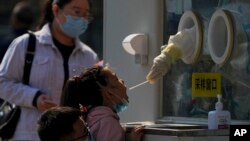The Chinese government has repeatedly locked down tens of millions of people at a time over the past three years under its zero-COVID policy. It is now deploying its considerable powers of state control to suppress protests against that policy.
But it has not managed to do what experts say would render the policy largely unnecessary: vaccinate and boost a greater share of its elderly population.
"That's what's been most puzzling about China's approach to this virus," said Jennifer Nuzzo, director of the Pandemic Center at Brown University School of Public Health, "because it's basically leaving wide open its biggest vulnerabilities."
Overall, about 90% of China is fully vaccinated. But among those age 80 and older, who are at the highest risk of death, just two-thirds are fully vaccinated. Only about 40% have received a booster, according to the National Health Commission.
Early to deploy vaccines
China was among the first to develop and deploy COVID-19 vaccines. The most widely used contain inactivated virus, a tried-and-true technology that has been used for decades. The country has not imported mRNA vaccines for its domestic population but has allowed foreigners to receive them. China also is developing its own mRNA vaccine.
While inactivated vaccines are not as potent as mRNA vaccines after the first or second dose at preventing severe illness and death, by the third dose they are equivalent. Both were greater than 97% effective in a recent study from Hong Kong published in the Lancet Infectious Diseases.
The third booster dose was especially important for older people because immunity wanes with age.
Chinese officials acknowledge the shortfalls in vaccinating older people, but they say the zero-COVID policy aims to protect vulnerable populations and guard its health care resources.
"Vaccination rates for the elderly and children are not high enough generally," Liang Wannian, head of the National Health Commission's COVID-19 response expert panel, told reporters in April.
"If we choose the so-called policy of coexisting with the virus, medical resources would be very likely to be overwhelmed, thus threatening the health of patients with background diseases, elderly people, children and the pregnant," Liang said. "Under such circumstances, we must stick to the general principle of dynamic zero-COVID."
Opening up would overwhelm hospitals
China fully opening up now would result in 620,000 deaths and more than twice as many patients needing intensive care as the nation has ICU beds, according to a Bloomberg Intelligence report.
It's not clear why the elderly have been lagging in vaccination. An editorial in The Lancet says one reason may be a lack of trust in domestic vaccine makers. It points to scandals including a 2018 case in which a Chinese manufacturer made useless diphtheria, pertussis and tetanus vaccines and falsified inspection data for a rabies vaccine. No one was reported hurt, but it may have undermined confidence.
It also could be cultural. Elders are respected in China's Confucian culture, and "older people are afforded autonomy to make decisions about their health," the editorial said.
The government has announced plans to increase vaccination rates among the elderly.
"Ultimately, what it boils down to is, unless China increases vaccine uptake, and in particular makes sure (to reach) the people who are most vulnerable to severe illness, they're really going to be stunningly vulnerable to this virus going forward," Brown University’s Nuzzo said.







